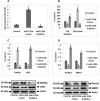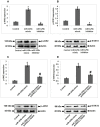Overexpression of miR125b Promotes Osteoporosis Through miR-125b-TRAF6 Pathway in Postmenopausal Ovariectomized Rats
- PMID: 33623402
- PMCID: PMC7894909
- DOI: 10.2147/DMSO.S288338
Overexpression of miR125b Promotes Osteoporosis Through miR-125b-TRAF6 Pathway in Postmenopausal Ovariectomized Rats
Abstract
Background: Postmenopausal osteoporosis is one of the most common types of osteoporosis that women suffer from. Studies involving molecular mechanisms for designing better therapeutic strategies for postmenopausal osteoporosis are still rare. The present study investigates the role of miR-125b in postmenopausal osteoporosis.
Methods: Microarray analysis was done to screen the gene database. Tissue samples of postmenopausal women were collected to study the miRNA profiles. MC3T3-E1 cells were used and were submitted for transfection. CCK-8 assay was done to check the viability of cells, whereas toxicity was done by lactate dehydrogenase assay kit. TargetScan was done to target genes of miR-125b followed by confirmation by Luciferase reporter assay. For animal studies a rat model of ovariectomized rats was created. Bone mineral density and biomechanics were measured by densitometer. The mRNA levels were assessed by qRT-PCR and proteins by Western blot assay.
Results: miR-125b was over-expressed in human osteoporosis samples. In vitro studies suggested that miR-125b suppressed the cell viability and promoted release of LDH, it also enhanced the RANKL/OPG ratio and suppressed levels of BMP2 and Runx2. Bioinformatics identified TRAF6 as a potential target of miR-125b, further confirmed by luciferase assay, also miR-125b negatively regulated the levels of TRAF6 gene in osteoporosis bones involving the JAK2/STAT3 cascade. In the rat model, miR-125b decreased the bone mineral density and biomechanical parameters in bones by altering the TRAF6 gene involving the JAK2/STAT3 pathway.
Conclusion: The outcomes suggested that miR-125b was responsible for the development of postmenopausal osteoporosis and promoted its progression by the TRAF6 gene via the JAK2/STAT3 pathway.
Keywords: JAK2/STAT3 pathway; TRAF6; miR‐125b; osteoporosis.
© 2021 Wang et al.
Conflict of interest statement
The authors declare no conflicts of interest for this work.
Figures







Similar articles
-
MiR-151a-3p Promotes Postmenopausal Osteoporosis by Targeting SOCS5 and Activating JAK2/STAT3 Signaling.Rejuvenation Res. 2020 Aug;23(4):313-323. doi: 10.1089/rej.2019.2239. Epub 2019 Sep 23. Rejuvenation Res. 2020. PMID: 31411118
-
MiR-320a was highly expressed in postmenopausal osteoporosis and acts as a negative regulator in MC3T3E1 cells by reducing MAP9 and inhibiting PI3K/AKT signaling pathway.Exp Mol Pathol. 2019 Oct;110:104282. doi: 10.1016/j.yexmp.2019.104282. Epub 2019 Jul 10. Exp Mol Pathol. 2019. PMID: 31301305
-
Eupatilin ameliorates postmenopausal osteoporosis via elevating microRNA-211-5p and repressing JAK2/STAT3 pathway.Environ Toxicol. 2024 Apr;39(4):2218-2228. doi: 10.1002/tox.24069. Epub 2023 Dec 21. Environ Toxicol. 2024. PMID: 38130072
-
MiR-125b Inhibits Cell Proliferation and Induces Apoptosis in Human Colon Cancer SW480 Cells via Targeting STAT3.Recent Pat Anticancer Drug Discov. 2022;17(2):187-194. doi: 10.2174/1574892816666210708165037. Recent Pat Anticancer Drug Discov. 2022. PMID: 34238196
-
miRNA-125b-5p Suppresses Hypothyroidism Development by Targeting Signal Transducer and Activator of Transcription 3.Med Sci Monit. 2018 Jul 20;24:5041-5049. doi: 10.12659/MSM.907510. Med Sci Monit. 2018. PMID: 30027933 Free PMC article.
Cited by
-
The expression of MIR125B transcripts and bone phenotypes in Mir125b2-deficient mice.PLoS One. 2024 Jul 8;19(7):e0304074. doi: 10.1371/journal.pone.0304074. eCollection 2024. PLoS One. 2024. PMID: 38976685 Free PMC article.
-
A Cancer-Related microRNA Signature Shows Biomarker Utility in Multiple Myeloma.Int J Mol Sci. 2021 Dec 5;22(23):13144. doi: 10.3390/ijms222313144. Int J Mol Sci. 2021. PMID: 34884950 Free PMC article.
-
Common miRNAs of Osteoporosis and Fibromyalgia: A Review.Int J Mol Sci. 2023 Aug 31;24(17):13513. doi: 10.3390/ijms241713513. Int J Mol Sci. 2023. PMID: 37686318 Free PMC article. Review.
-
The characteristic expression of circulating MicroRNAs in osteoporosis: a systematic review and meta-analysis.Front Endocrinol (Lausanne). 2024 Dec 16;15:1481649. doi: 10.3389/fendo.2024.1481649. eCollection 2024. Front Endocrinol (Lausanne). 2024. PMID: 39736860 Free PMC article.
-
STAT3-mediated osteogenesis and osteoclastogenesis in osteoporosis.Cell Commun Signal. 2022 Jul 25;20(1):112. doi: 10.1186/s12964-022-00924-1. Cell Commun Signal. 2022. PMID: 35879773 Free PMC article. Review.
References
-
- Chen X, Zhang S, Chen X, et al. Emodin promotes the osteogenesis of MC3T3‐E1 cells via BMP‐9/Smad pathway and exerts a preventive effect in ovariectomized rats. Acta Biochimica et Biophysica Sinica. 2017;49:867–878. - PubMed
-
- Eastell R, O’Neill T, Hofbauer L, et al. Postmenopausal osteoporosis. Nat Rev Dis Primers. 2016;2:1–16. - PubMed
-
- Black DM, Rosen CJ. Postmenopausal osteoporosis. N Engl J Med. 2016;374:254‐262. - PubMed
LinkOut - more resources
Full Text Sources
Other Literature Sources
Miscellaneous

